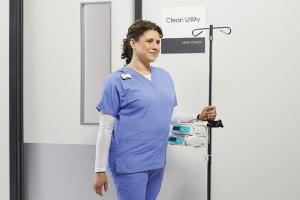Cleaning and disinfection products for health care

Hospitals pose major challenges to makers of cleaning and disinfection products. Environmental services (EVS) managers must balance employee and patient safety with the need to kill dangerous and emerging pathogens.
Additionally, hospitals have seen an increased need for external validation of cleanliness during the coronavirus pandemic. “COVID-19 exposed challenges in security of supply,” says Chris Paradise, senior marketing manager of environmental hygiene at Ecolab, St. Paul, Minn. “During the height of the pandemic, chemical entry onto the Environmental Protection Agency’s (EPA’s) List N was critical for both suppliers and hospitals. We recently have seen renewed interest in other organisms of concern, such as C. auris.”
Hospitals must balance efficacy and safety when it comes to cleaning and disinfection. The COVID-19 pandemic emphasized the importance of developing comprehensive cleaning plans to address new pathogens. “Infection prevention and EVS teams need to work together to provide continual evaluation and education of protocol and products to fight the hierarchy of pathogens,” says Martin McGonagle, general manager at SC Johnson Professional Healthcare, Charlotte, N.C.
Optimizing disinfectants
Infection control and EVS staff continue to struggle with optimizing the application of chemical disinfectants, according to K. Mark Wiencek, Ph.D, lead microbiologist at Contec Inc., Spartanburg, S.C. “There are no perfect disinfectants; users must strike a balance among several factors, including quick wet contact times, material and personnel compatibility, and cost.”
Of course, the primary purpose of environmental cleaning and disinfection is to keep patients and workers safe from health care-associated infections (HAIs). “The leading cause of HAIs in hospitals is C. difficile, a spore-forming pathogen that can survive on environmental surfaces for several months,” says Doe Kley, senior infection preventionist at The Clorox Company, Oakland, Calif. “Pathogens such as C. diff can be picked up on the hands of workers from contaminated surfaces — especially high-touch surfaces — and then spread to patients.”
Kley adds that maintaining a clean and sanitary environment is not only a regulatory requirement but an important means of breaking the infection transmission chain. Hospitals are very complex systems with many stakeholders and they have many types of critical surfaces that require frequent cleaning. “All of this poses unique challenges for hospital environmental cleaning and disinfection,” she says.
Compatibility is another challenge. Medical device manufacturers are incentivized based on how their equipment performs and functions, but not necessarily on how it holds up to common hospital cleaners and disinfectants, according to Marc-Oliver Wright, MT(ASCP), MS, CIC, FAPIC, clinical science liaison for the central region at PDI Inc., Woodcliff Lake, N.J. “Often, the instructions for cleaning are unacceptable from an infection prevention point of view. Hospitals should incorporate cleaning and disinfection review as part of their equipment or device purchasing decisions upstream to avoid negative issues later on.”
Remote facilities, such as ambulatory care centers and off-site clinics, pose additional challenges to vendors. Off-site facilities have experienced rapid growth over the years and may not fall under as tight a control or oversight as a hospital. “They may be run by third-party contractors or have less connection to hospital-driven training and protocols,” says Stephanie M. Martin, product technical leader at Kimberly-Clark Professional, Roswell, Ga.
Many off-site facilities do not have staff dedicated to environmental hygiene, nor training on the proper products and procedures to clean and disinfect. “Everyone must know that they are responsible for cleaning and disinfecting, as well as the expectations for frequency,” says Larinda Becker, executive director of marketing for infection prevention at Diversey, Fort Mill, S.C. “This often gets missed.”
Many clinics and ambulatory settings utilize local contracted cleaning services — often the same ones that clean non-health care settings such as offices or retail spaces. “These services may lack the rudimentary knowledge of health care spaces or the expertise in utilizing disinfectants for the appropriate wet/contact/kill time,” Wright says.
A broad spectrum
Given all these challenges, it is important that hospitals choose cleaning and disinfection products that are effective against a broad spectrum of pathogens, are able to stay wet for the required contact time, and are safe and pleasant enough to be used around patients and staff. Many products recently introduced to the health care market have these qualities.
Clorox Healthcare has introduced Spore Defense Cleaner Disinfectant, a low-odor and low-residue bleach that is safe to use in sensitive patient settings. “This sporicidal disinfectant kills C. difficile in five minutes, C. auris in three minutes and 44 other health care-relevant pathogens in one minute,” Kley says. It is available for use through CloroxPro electrostatic devices and as a refill gallon for manual disinfection or use with other electrostatic devices.
Contec Inc. manufactures a disinfectant product called Sporicidin Disinfectant Solution that has traditionally been used for biohazards and mold remediation. “Due to shortages of disinfectants during the pandemic, Contec received EPA List N approval for Sporicidin against the SARs-CoV-2 virus and was able to divert supply to health care facilities,” Wiencek says.
Ecolab offers the Disinfectant 1 wipe, which features 44 one-minute kill claims on key organisms of concern to hospitals and requires no personal protective equipment (PPE). The nonwoven, disposable wipe is saturated with a multipurpose cleaner and disinfectant. “With 60-second kill on 44 organisms, it can help reduce the risk of HAIs,” Paradise says. “Also, the pre-saturated wipe is available in sizes and quantities that meet specific turnover volume needs.”
Diversey recently introduced Oxivir 1 ready-to-use cleaner and disinfectant wipes, powered by Accelerated Hydrogen Peroxide. It is effective against bacteria, enveloped and nonenveloped viruses, tuberculosis and fungi in one minute or less, according to Becker. “With disinfectant claims against more than 75 key pathogens, including C. auris and SARS-CoV-2, it offers a fast, effective, sustainable solution. Also, the Oxivir family of products is nonirritating to the skin and eyes, requires no PPE, and is compatible with most common health care surfaces and equipment.”
PDI has introduced a continuously active disinfectant, the Sani-24 Germicidal Disposable Wipe. It kills pathogens on contact within a minute and keeps killing organisms that settle on or touch the surface for the next 24 hours or 96 touches. “Remember that emergency department waiting room that does not get disinfected as often as it should? With a continuously active disinfectant, it may not be as much of a risk as it once was,” says Alice Brewer, MPH, CIC, director of clinical affairs for Tru-D SmartUVC, a PDI solution.
Tork, an Essity brand, Philadelphia, offers reusable microfiber cleaning cloths as a sustainable option for hospitals. The material is durable and can be laundered up to 300 times without losing efficacy, according to Deborah Chung, North America marketing manager for health care at Essity Professional Hygiene. “Its fine fibers act as a hook, catching and holding onto particles such as dirt and microorganisms,” she says. “This is essential to avoid cross-contamination in a health care setting.”
Microfiber cleaning cloths leave little to no lint behind and dry quickly, allowing fewer germs to grow. The material makes the cloth immune to quaternary binding, a common cleaning problem, Chung adds. Also, the reusable cloths come in a variety of colors, making it easy to assign a color to a specific team or area to help avoid cross-contamination.
Kimberly-Clark offers Scott 24 Hour Sanitizing Wipes. “Although not a hospital-grade disinfectant, they are registered with the EPA for disinfecting against numerous strains of bacteria and viruses, including SARS-CoV-2 (though not approved for use against SARS-COV-2 in California),” Martin says. “When used as directed, they offer general disinfection benefits coupled with the benefit of delivering a residual coating to nonporous services capable of killing 99.9% of bacteria for 24 hours, in spite of multiple touches.”
Cintas Corp., Cincinnati, has developed a health care-grade ultramicrofiber (HGUM) that can trap, capture and remove pathogens from the patient environment, according to Aaron Jett, clinical solutions manager for health care. “HGUM can remove pathogens that make up the bioburden and dry surface biofilm. They are compatible with all EPA-registered disinfectants, including quaternary ammonium compounds, and can be laundered (reprocessed) according to the parameters of Centers for Disease Control and Prevention guidelines.”
HGUM can withstand high heat and bleach, which ensures hygienically clean outcomes, Jett says. “Across the country, users report cleaner facilities, reduced C. difficile infection rates over 30% and reduction of other pathogens such as C. auris. Also, patient throughput has improved due to lower room turnover times.”
Related equipment
Advances also have been made in application equipment. Electrostatic technology, with its even distribution and 360-degree wrap of disinfectant, is a solution for surfaces that are often missed during manual cleaning, according to Kley. “Clorox has added new devices and chemistries to its electrostatics portfolio. We recently introduced the Clorox Total 360 ProPack, a lightweight backpack device designed for spaces where more maneuverability is needed.” Kley says the Clorox TurboPro hand-held device is designed for smaller jobs where portability is required. “We also offer disinfecting and sanitizing solutions that are EPA-registered for use through sprayer devices,” she says.
Contec Inc. focuses on providing applicators for effective cleaning and application of many different types of sanitizers and disinfectants. “Contec’s laundry-free mop pads and wipes, along with lightweight, sturdy hardware, such as the ZeroGravity mopping system, help make cleaning and disinfection easier and safer, which leads to greater compliance with stricter cleaning guidelines,” Wiencek says.
A shift to disposable products was underway before the pandemic, due to concerns and costs associated with re-laundering microfiber towels and mops, including cross-contamination and degradation of textiles through repeated use and laundry cycles, Wiencek says. “This has continued as more professionals have experienced the benefits of disposable products during the pandemic.”
Employee training is another area to consider when it comes to improving cleanliness. Tork offers Tork Interactive Clean Hospital Training, a desktop tool designed to facilitate the training process for cleaning health care facilities, according to Chung. “The training is free and available in multiple languages. It is based on the Association for the Health Care Environment’s Practice Guidance for Health Care Environmental Cleaning.”
Green cleaning, the use of environmentally friendly chemicals or natural materials, is a new frontier and arguably a challenging one, according to Wright. “While some agents break down into water and oxygen, some pathogens need an extra push. This, in part, is what led PDI to develop Sani-HyPerCide disinfectants, a hydrogen peroxide-based solution that also is effective against major health care pathogens such as C. difficile. The challenge comes in finding the sweet spot between an effective solution and one that is better for the environment.”
Adjunct technology
McGonagle predicts that the use of adjunct technology such as UV equipment, electrostatic sprayers and devices designed to clean the entire environment will help to supplement current cleaning and disinfection practices, especially in high-risk areas. Of course, effective training will be needed to ensure the proper use of adjunct technology and the achievement of cleanliness goals.
Neal Lorenzi is a freelance writer and regular contributor based in Mundelein, Ill.
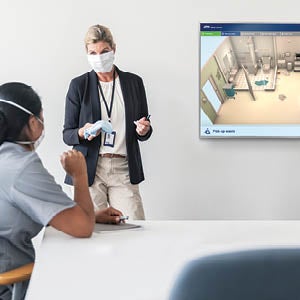
BY THE BOOK
Tork Interactive Clean Hospital Training is based on the AHE Practice Guidance for Health Care Environmental Cleaning. Tork, an Essity brand
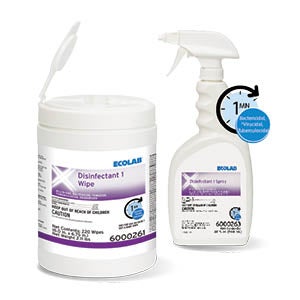
WIPING IT OUT
Disinfectant 1 wipe and spray can help reduce HAIs with 60-second kill on 44 organisms. Ecolab
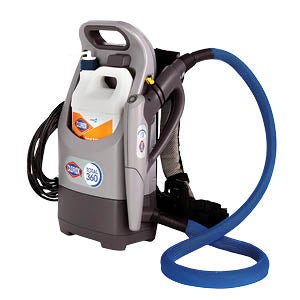
FOR TIGHT SPACES
The Total 360 ProPack is a lightweight backpack device designed for spaces where maneuverability is needed such as cluttered spaces or stairwells. Clorox Healthcare
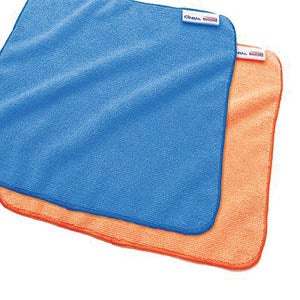
BEATING BIOBURDEN
Health care-grade ultramicrofiber can remove pathogens that make up the bioburden and dry surface biofilm. Cintas Corp.
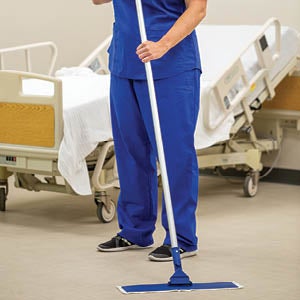
MOPPING UP
The ZeroGravity mopping system with laundry-free mop pads enhances the consistency and convenience of cleaning and applying disinfectants to floors. Contec Inc.
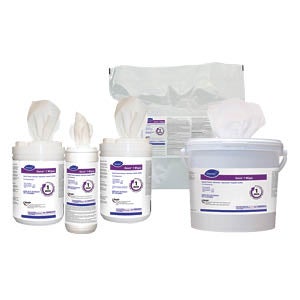
WHEN SECONDS COUNT
Oxivir 1 ready-to-use cleaner/disinfectant wipes are effective against bacteria, enveloped and nonenveloped viruses, tuberculosis and fungi in one minute or less. Diversey
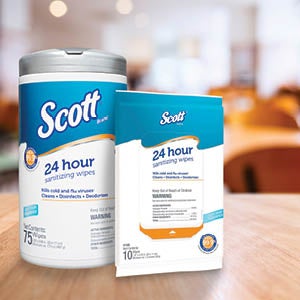
AROUND THE CLOCK
Scott 24 Hour Sanitizing Wipes offer general disinfection benefits, including disinfection of coronavirus. Kimberly Clark Professional
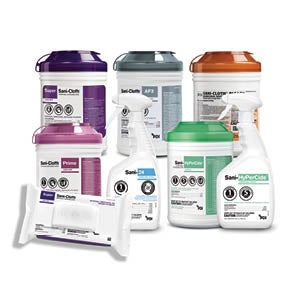
BETTER PATIENT FLOW
Effective against 30 microorganisms in two minutes, this product’s fast contact time allows for a quick room turnover. PDI Inc.
Neal Lorenzi is a Mundelein, Ill.-based contributor to Health Facilities Management.




